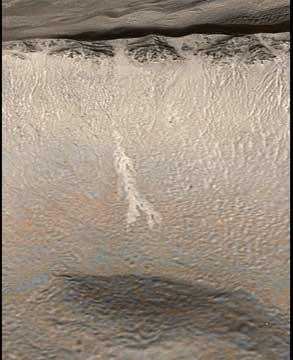|
News Notes
Space
Water responsible for martian landscape?
 |
| The remnants of a recent debris flow turned up in photos of a gully on Mars. Some researchers speculate the flow could imply the presence of water, while others think it resulted from a dry, granular flow. Image courtesy of NASA/JPL/MSSS. |
NASA’s Mars Global Surveyor satellite may have made its final transmission back to Earth, but not before leaving a team of researchers with some revealing snapshots of the planet’s changing surface. By analyzing “before and after” images from the last seven years, researchers caught impact events and debris flows in the act of altering the martian landscape.
The craters and debris flow features differ in their implications, researchers reported Dec. 8 in Science. Newfound craters, for example, allowed the team for the first time to test the accuracy of a popular method of dating planet surfaces. Meanwhile, features left behind from new debris flows suggest that fluid seeped down the side of a gully, and might have contained water, Michael Malin of Malin Space Science Systems in San Diego, Calif., wrote in the paper.
Researchers have long observed the martian surface to be riddled with elaborate meandering gullies and channels, which previous studies have found to be relatively young, says Kenneth Edgett, a geologist at Malin Space Science Systems and co-author of the paper. But whether or not gullies continue to be shaped today, and if so, by what forces, remained unknown.
To find out, Malin and colleagues set out in 2000 to image thousands of gullies at hundreds of sites on Mars. The team then compared images of the same sites over time to see if any new formations turned up.
The team found two bright flow-like features that branch off and divert around obstacles. The first feature, discovered on the bank and floor of a gully within the Terra Siernum crater, formed sometime between December 2001 and April 2005; The second feature, discovered inside a gully on the wall of the Centauri Montes crater, formed between August 1999 and February 2004.
That only two such features were discovered suggests that “these are not common,” Edgett says. “Now it’s just a question of whether water was involved or whether it was a dry granular flow.”
Malin suggests that the flow’s brightness — 25 percent brighter than surrounding material — could imply that water was involved. And brightness is “not typical” of the movement of dry debris, Edgett says, noting that other disturbances on Mars, such as avalanches, dust devils and rovers, leave behind dark tracks. An explanation for the light tone could be that water moved from belowground to the surface, where it flowed and then froze, persisting as frost, Malin wrote in the paper.
Edgett says, however, that he is “not comfortable” with the ice explanation, because the feature “persists over years.” The bright tone could also be the result of an alternate material, such as salt, he says. Or, he says, the flow may have sorted materials such that finer, brighter grains moved to the top. Currently, there is “no way to distinguish” the composition of the flow, and information gathered so far “doesn’t prove it’s water,” Edgett says. “But it’s a beacon that says ‘look here, this could be something.’”
Allan Treiman, a planetary geologist at the Lunar and Planetary Institute in Houston, Texas, and not associated with the study, says that he has studied martian gullies and is “quite critical” of the team’s interpretation that the gullies represent water-rich debris flows. The idea that the bright tone is caused by frost “is possible, but certainly not proven,” he says. “The difference in tone could have many causes,” he says, including salt.
Instead, Treiman says he has been “flogging” the idea that the light-toned gully flows, as well as the planet’s more common dark slope streaks, are the result of two different types of avalanches, both composed of dry dust and sand. Massive avalanches — dense flows of dry particles seen on Earth in the form of snow or volcanic ash — could lead to the large, gully features, while smaller “triangular” avalanches could lead to slope streaks.
Still, “it’s really cool that Malin [and his colleagues] are seeing changes happen on Mars over a few years, especially the few gully flows that they’ve documented,” Treiman says. “So, Mars is not such a static place after all.”
While the “water on Mars” story has received much public attention, it has been the impact crater part of the study that has led astronomers to “light up like Christmas trees” upon learning about it, Edgett says.
Scientists have long used craters to determine the age of a planet’s surface: The older the surface, the more likely it is to be riddled with more, as new materials have not filled them in. Until now, however, astronomers were uncertain about the accuracy of this method, as no one had ever observed new craters forming, Edgett says.
To test the current models, the team monitored the number of new impact craters that formed within an area of 21.5 million square kilometers over a period of seven years. During that period the team counted 20 new craters, supporting the rate used in prior models.
Kathryn Hansen

 Subscribe
Subscribe

